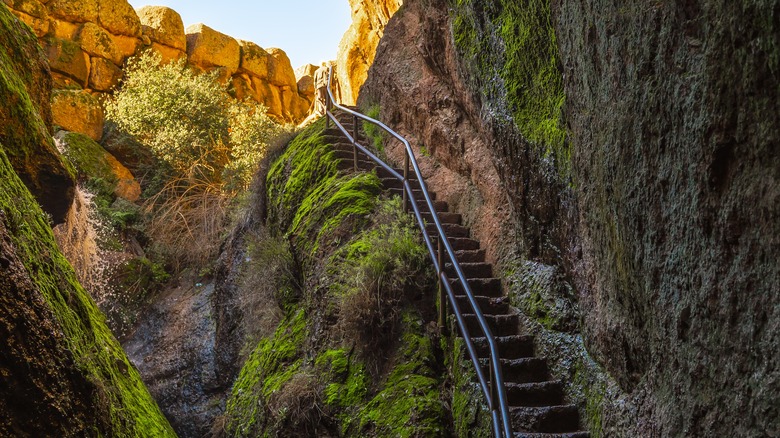One Of Pinnacles National Park's Best Hikes Boasts A Unique Cave And Crystal-Clear Reservoir
There are more than 30 miles of trails through Pinnacles National Park that take hikers to the tops of rocky slopes and through the many caves formed by rock falls in the region — just make sure to pack a flashlight when you visit. While it may not have the impressive 80-miles of underground tunnel systems of Kentucky's Mammoth Cave National Park, a trip to Pinnacles National Park wouldn't be complete without a trip into the darkness of Bear Gulch Cave.
Avid hikers know that Pinnacles National Park is a fantastic destination for avoiding crowds and admiring wildlife. There, you can seek out glimpses of rare California Condors soaring overhead or spot bobcat tracks on the ground beneath your feet. However, to see the home of some of the most fascinating animals in the park, you're going to have to take a darker route into Bear Gulch Cave. There, you'll find a thriving colony of Townsend's Big-eared Bats. After you make your way back out of the dark, you can continue on your journey along Bear Gulch Cave Trail the beautiful Bear Gulch Reservoir to see the rock formations that give this national park its name reflected back at you in the water.
What you can expect on Bear Gulch Cave Trail
Pinnacles National Park has trails that are only for experienced hikers, like the infamous High Peaks Trail — but you don't have to worry about traversing switchbacks on Bear Gulch Cave Trail. This trail is considered an easy one by most hikers and only takes about an hour — though if it's crowded you'll need to park at the Pinnacles campground, which will add a lot of time to your trek. Along Bear Gulch Cave Trail, you'll find a series of little caves so short they're more like brief tunnels over the trail. Quickly, however, you'll find yourself having to choose whether you'd rather go over or under the rocks. If you choose over, you'll see one of the most incredible geological formations in the park: The Monolith. If you choose under, however, you'll find yourself in Bear Gulch Cave.
At national parks with extensive cave systems like South Dakota's Wind Cave National Park, you need to book a tour and go down into the cave with a park ranger guide. At Bear Gulch, that's not necessary. The trail continues through the cave, keeping the path stable, easy to follow, and not too uneven. You'll even find the occasional step up or down or place to grab a railing along the way. However, you'll definitely need a flashlight if you don't want to be feeling your way along the walls with no visibility. When you climb back up, you'll find yourself in the bright sunlight again, and you'll be able to see some of the park's famous pinnacles and the crystal clear Bear Gulch Reservoir.
Plan your trip at the right time of year to explore the cave
If you're planning your trip to Pinnacles National Park specifically to experience this unique cave trail for yourself, you should be aware that it is often closed. Sometimes, that is because of safety hazards like flooding or rock falls, but it can also be to protect the cave's inhabitants — a colony of rare bats. The cave is divided into two sections, the upper and lower cave. The upper cave is often closed because that is where the bats live, but the lower cave is typically open to explorers.
If you want to explore both parts of the cave, your best bet is to plan your trip for the end of March or the end of October. While these closures can be unpredictable, both sections of the cave are usually open then. It's best to avoid trips from mid-May to mid-July. Not only will that save you from the worst of the California summer heat, during that time both sections of the cave are closed to protect new baby bats.


